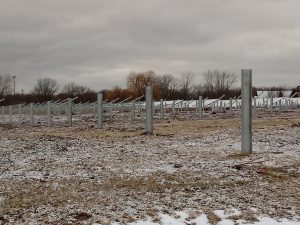Solar energy farms gaining acceptance at school campuses
By Gregory Harutunian For Chronicle Media — February 6, 2020
The solar panel installation at the Warren Township High School District 121 Almond Road campus began in October. (Photo by Gregory Harutunian/for Chronicle Media)
The growing awareness that creating renewable energy sources for electrical needs and as an environmentally friendly touchstone has steadily gained a home at school campuses within the state of Illinois, by providing a cost-effective means for energy needs and a curriculum component for science education.
Most recently, Warren Township High School District 121 in Lake County and Huntley School District 158 in McHenry County are looking forward to turning on the power this spring.
The passage of the in 2017 was aimed at moving renewable energy sources forward with a goal of up and running projects set at 16 percent by 2020, and 25 percent in 2025. Local school districts had already begun discussions about the potential of using district-owned properties as solar panel installations providing an alternative to mounting electricity expenses.
In 2018 and 2019 respectively, Grayslake Community Consolidated District 46 and Mundelein Elementary School District 75, both in Lake County, embarked on contracting with professional firms to erect solar panel fields to generate electrical power, not only for their campuses but for the community via connection to the power grid.
“A lot of the elementary and middle schools are finding the value in these projects for a number of reasons including the educational components,” said District 121 Superintendent John Ahlgrim. “It is modeling for our students in showing an awareness and involvement with renewable energy, and already we are reviewing methods of incorporating this solar field into science and educational projects. We’re hoping to be operating by this spring, and at the latest, next fall.
“One of the most important factors is that we can save the approximately $300,000 annual expenses on electrical and energy costs. Those monies can be put back into school programs and invested in the students,” he said.
The solar panels are being placed at the district’s Almond Road Campus, located at 34090 Almond Road in Grayslake. The district board engaged Lombard-based Performance services, Inc. for its implementation, and was “one of several building projects explicitly identified in a 2018 bond issuance of $23 million … the Almond Campus solar project cost is nearly $7.3 million for installation, and the district will receive approximately $2.5 million in rebates and incentives within the first five years of operation,” according to a community newsletter.
The project started in October, with tree removal on two adjacent parcels along Gages Lake Road.
That same month, the school board had approved a re-structured financing proposal from the company, after delays with Solar Renewable Energy Credit incentives had called a halt to the original proposal for the solar farm. The anticipated completion date is by mid-summer this year.
In McHenry County, District 158 officials saw the dual potential of a reduction in energy costs and being sensitive to the community regarding tax levy amounts paid to the school district. San Francisco-based forefront Power Inc., a wholly owned subsidiary of Mitsui & Co., Ltd was contracted for the project to install solar panel fields at the district’s Square Bard Road and Reed Road campuses, which contain six of the district school facilities, and the Harmony road facility, later this year.
“We got the idea to do this in the spring of 207, although the first action came in 2011, when we engaged in an energy census,” said Dist. 158 Superintendent Scott Rowe. “The prospect is saving about $4.2 million in costs over a 20-year period. We rely on land property taxes, and we take our commitment seriously … our community feels the pinch every time the tax levy goes up. We are a Tier 2 school, funded at 67 percent of adequacy in state funding levels. This is big.
“The farm covers just 14 acres, with nine schools on the three campuses, and this will handle 80 percent of the energy we envision. We’re exercising our leadership to support the taxpayers, while doing the right thing for the environment,” he said.
Rowe also said the installation company partners with Schools Powers for educational projects that coincide with the state of Illinois Learning Standards and concentration areas. Its website states, it was, “Founded in 2011 (and) provides K-12 educators with an easy way to add innovative lesson components that are project-based, Common Core Standards-based, and easily fit into exiting Math, Science and Technology curricula.”
Rowe sees renewable energy installations being placed in communities, as the incentives become more readily attainable.
“It’s time for the state and county to become aware of our environment and put some action behind it,” said Rowe.







